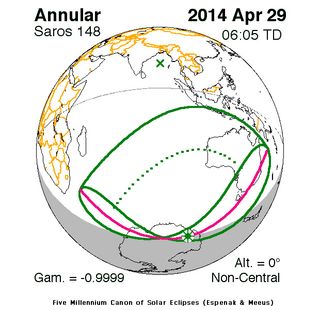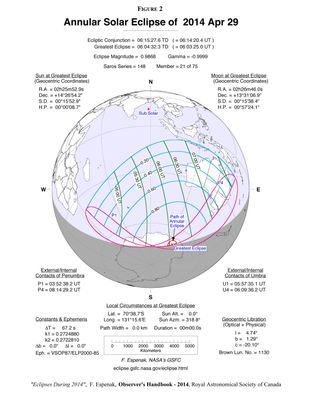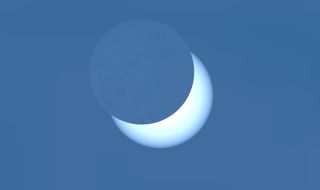'Ring of Fire' Annular Solar Eclipse of April 29, 2014 (Visibility Maps)
Annular Solar Eclipse of April 28-29, 2014

This NASA chart shows the shadow path of the "ring of fire" annular solar eclipse of April 28-29, 2014. The region of maximum eclipse will be over an uninhabited region of Antarctica, but a partial solar eclipse will be visible from Australia. [Read the Full Preview Story Here]
“Ring of Fire” Seen in Northern Territories, Australia

The annular solar eclipse of April 29, 2014 could create a dazzling "ring of fire" effect at its peak (see this image), but the event will occur over an uninhabited area of Antarctica and will likely go unseen. In this image: Astronomer Jay Pasachoff sent in this photo on May 10, 2013 capturing the annular solar eclipse at the moment of the "ring of fire.” He took the image from a site 43 miles (70 km) north of Tennant Creek, Northern Territories, Australia. [Read the Full Preview Story Here]
Partial Solar Eclipse Visible from Australia: April 2014

The annular solar eclipse of April 28-29, 2014 will be visible as a partial solar eclipse from parts of Australia and southern Indonesia, weather permitting, as shown in this illustration. [Read the Full Preview Story Here]
April 28-29, 2014 Solar Eclipse Visibility Map

This NASA chart shows the shadow path of the "ring of fire" annular solar eclipse of April 28-29, 2014. The chart, prepared by NASA eclipse expert Fred Espenak, also lists times for the maximum eclipse, as well as start and stop times. The region of maximum eclipse will be over an uninhabited region of Antarctica, but a partial solar eclipse will be visible from Australia. [Read the Full Preview Story Here]
Guide to Solar Eclipses (Infographic)

How Solar Eclipses Work: When the moon covers up the sun, skywatchers delight in the opportunity to see a rare spectacle. See how solar eclipses occur in this Space.com infographic. [Read the Full Preview Story for April 29 Here]
Our Solar System: Ring of Fire Sequence

The Moon’s orbit about the Earth is not perfectly circular, so that at different times the Moon can be slightly closer or further away than usual. This composite shot shows the progress of an annular eclipse in May 2013. [Read the Full Preview Story for April 29 Here]
Annular Solar Eclipse, April 2014

The annular solar eclipse of April 29, 2014 will only be total in a small area in Antarctica, but will be widely seen as a partial eclipse. The partial phases all be visible from most of Australia, and far across the southern Indian Ocean. It is seen here from Hobart, Tasmania. [Read the Full Preview Story Here]
Get the Space.com Newsletter
Breaking space news, the latest updates on rocket launches, skywatching events and more!
Join our Space Forums to keep talking space on the latest missions, night sky and more! And if you have a news tip, correction or comment, let us know at: community@space.com.

Space.com is the premier source of space exploration, innovation and astronomy news, chronicling (and celebrating) humanity's ongoing expansion across the final frontier. Originally founded in 1999, Space.com is, and always has been, the passion of writers and editors who are space fans and also trained journalists. Our current news team consists of Editor-in-Chief Tariq Malik; Editor Hanneke Weitering, Senior Space Writer Mike Wall; Senior Writer Meghan Bartels; Senior Writer Chelsea Gohd, Senior Writer Tereza Pultarova and Staff Writer Alexander Cox, focusing on e-commerce. Senior Producer Steve Spaleta oversees our space videos, with Diana Whitcroft as our Social Media Editor.
